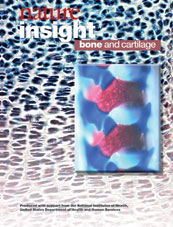
Bone and cartilage
Vol.
423, No. 6937 (15 May 2003).
|![]() PDF
PDF![]() (150
(150![]() K)
K)![]() |
|
 |
Cover
illustration |
Bone and cartilage comprise the skeleton — a finely patterned structure that provides mobility, protection of vital organs, and housing of the bone marrow. Because bones are the most inert and enduring of our mortal remains, it is surprising what dynamic and highly tuned organs they are during life, as they must simultaneously balance growth to achieve strength and resilience, and repair without overgrowth.
This balance is achieved by bone remodelling — an interplay of mineral deposition and resorption by specialized bone cells, which is constantly occurring on a microscopic scale throughout our bodies. An imbalance in remodelling is what leads to the debilitating loss of bone mass called osteoporosis, a condition that is estimated to afflict 200 million women world wide, and often leads to immobility and death. This and other diseases of bone and cartilage are responsible for a large portion of healthcare expenditures in developed countries — US$14 billion is spent annually on treating osteoporotic fractures in the United States alone.
These statistics emphasize the need for a better understanding of both the fundamentals of skeletal biology and the pathologies associated with it, which in addition to osteoporosis, include birth defects, genetic diseases, and rheumatoid and osteoarthritis. Indeed, as human life is prolonged by biomedical advances, the weak link in our health and longevity may become the strength of our bones and mobility of our joints.
This month's Insight presents a collection of articles that explore some key elements of skeletal biology, including how skeletal structures are patterned and bones and cartilage develop, the influence of genetics over human skeletal biology, the signalling pathways and transcription factors that control bone mass, and the pathogenic mechanisms of rheumatoid arthritis.
NATALIE
DEWITT
Senior Editor
 | |||
| The
complexities of skeletal biology GERARD KARSENTY doi:10.1038/nature01654
| 316 | ||
 | |||
| Deciphering
skeletal patterning: clues from the limb FRANCESCA V. MARIANI AND GAIL R. MARTIN doi:10.1038/nature01655
| 319 | ||
| Cranial
skeletal biology J. A. HELMS AND R. A. SCHNEIDER doi:10.1038/nature01656
| 326 | ||
| Developmental
regulation of the growth plate HENRY M. KRONENBERG doi:10.1038/nature01657
| 332 | ||
| Osteoclast
differentiation and activation WILLIAM J. BOYLE, W. SCOTT SIMONET & DAVID L. LACEY doi:10.1038/nature01658
| 337 | ||
| The
genetic basis for skeletal diseases ELAZAR ZELZER AND BJORN R. OLSEN doi:10.1038/nature01659
| 343 | ||
| Control
of osteoblast function and regulation of bone mass SHUN-ICHI HARADA AND GIDEON A. RODAN doi:10.1038/nature01660
| 349 | ||
| Evolving
concepts of rheumatoid arthritis GARY S. FIRESTEIN doi:10.1038/nature01661
| 356 | ||